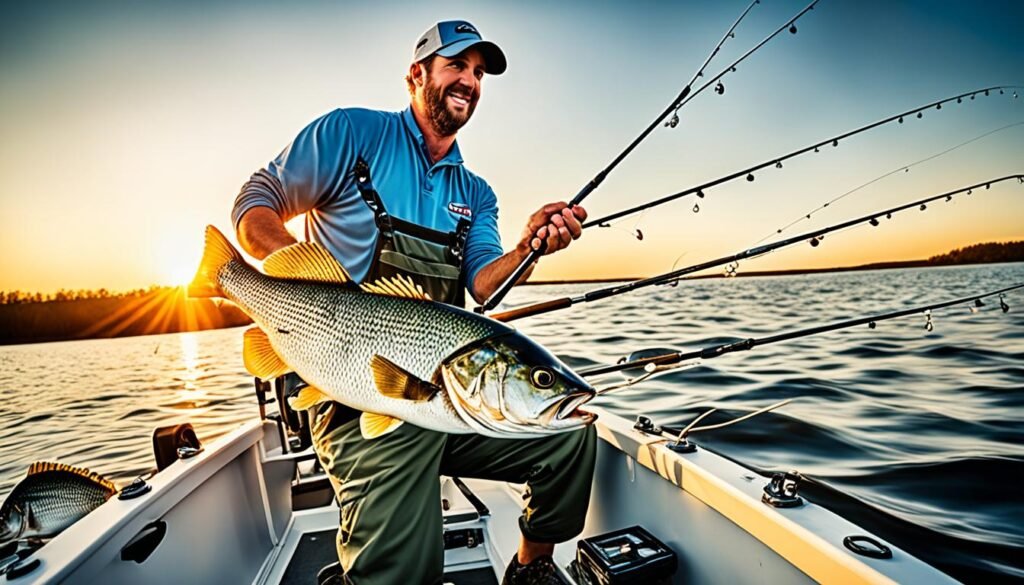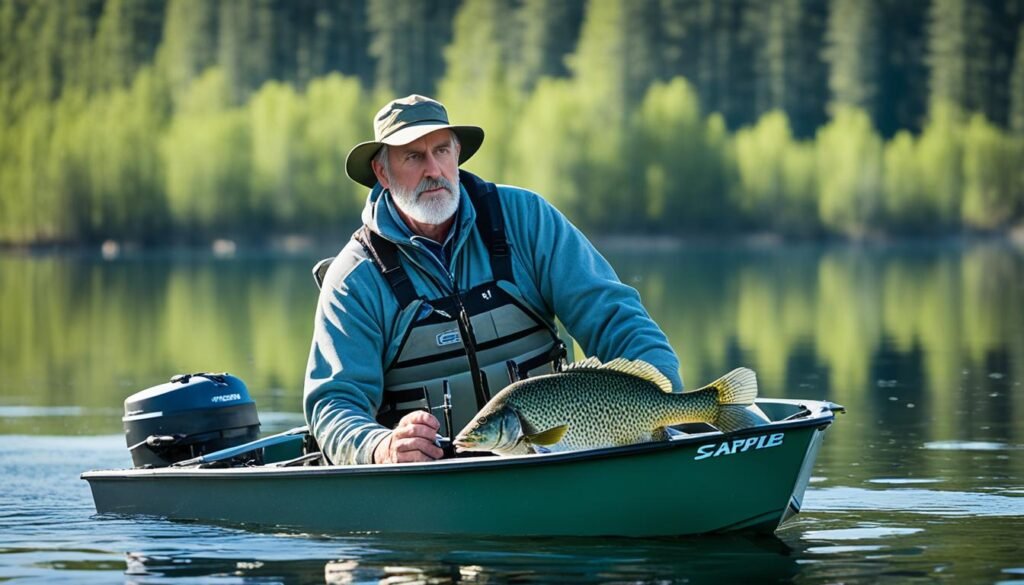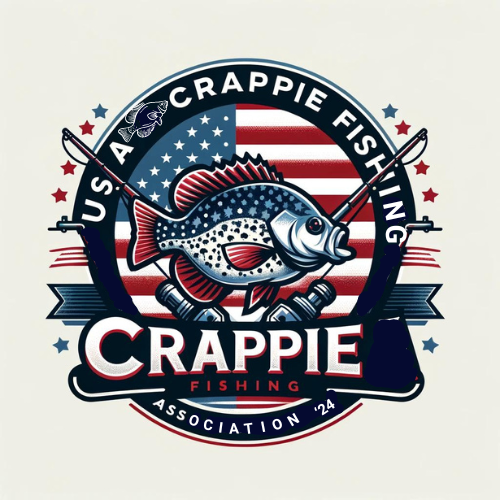When it comes to crappie fishing, every angler has their own secret tactics and techniques. However, if you want to catch monster crappies and take your fishing game to the next level, it’s time to explore the proven strategies that the experts swear by.
Meet Mike, an avid angler who has been fishing for crappies for over two decades. Like many others, Mike started out with the basics, but his passion for catching big crappies pushed him to go beyond the conventional methods. Determined to master the art of crappie fishing, he sought advice from experienced anglers, studied the behavior of these elusive fish, and tested different tactics on the water.
One day, during a particularly challenging fishing trip, Mike stumbled upon a hidden gem of a fishing spot. Tucked away in the backwoods, this unconventional location was far from the popular fishing spots that most anglers frequented. But it was here that Mike discovered the first of many proven tactics for catching monster crappies. Armed with this newfound knowledge, Mike’s fishing success skyrocketed.
Don’t worry if you’re just getting started or have been struggling to catch more crappie. In this article, we’ll dive deep into the best crappie fishing techniques, the secret strategies that can help you catch big crappies, and the valuable insights that will take your crappie fishing success to new heights. Get ready to transform your catch and become a master of crappie fishing!
Key Takeaways:
- Explore unconventional fishing spots for hidden crappie hotspots.
- Don’t shy away from fishing in challenging weather conditions.
- Use different lures and baits to entice finicky crappies.
- Target pre-spawn and spawn periods for optimal crappie fishing.
- Don’t overlook deep water and brush piles as potential crappie havens.
Fishing Unconventional Spots for Big Crappies
When it comes to catching big crappies, thinking outside the box and exploring unconventional fishing spots can make all the difference. These hidden gems, often overlooked by other anglers, can be the secret to reeling in monster crappies.
Unconventional spots for crappie fishing include fallen trees, submerged treetops, and main river points away from heavy fishing pressure. These areas provide the perfect cover and feeding grounds for big crappies.
By venturing into these unconventional spots and utilizing special techniques, you can significantly increase your chances of hooking into monster crappies. For example, leaning over limbs and casting into tight openings will help you reach crappies hiding in hard-to-reach areas.
Don’t be afraid to explore the less-fished areas and try something different. You might just uncover a crappie hotspot that others have overlooked.
The Art of Leaning Over Limbs
Leaning over limbs is a technique that involves carefully casting your bait over branches and limbs that are hanging out of the water. By doing so, you can reach crappies hiding in secluded areas and increase your chances of a successful catch.
To effectively lean over limbs, start by identifying a promising target—a limb, a branch, or a fallen tree partially submerged in the water. Carefully position yourself and your fishing rod to get the perfect angle for casting.
Using your rod, gently guide your bait over the limb and into the water, aiming for the spot where you think the crappies might be hiding. This technique requires precision and patience, but it can lead to some incredible catches.
“Fishing in unconventional spots is a game-changer for crappie anglers. These hidden areas hold big crappies that are often overlooked by others. Don’t be afraid to explore and experiment with different techniques to unlock the potential of these unconventional fishing spots.” – Mark Johnson, Professional Angler
Explore the Uncharted Waters
When it comes to fishing unconventional spots, the key is to explore new areas and venture into uncharted waters. This means going off the beaten path and discovering hidden crappie hotspots that other anglers may not know about.
The best way to find these hidden gems is to research and gather information from local anglers, fishing forums, and online fishing resources. Look for areas where fallen trees, submerged treetops, or other types of cover are abundant. These spots often hold the biggest and most elusive crappies.
Remember, success often comes to those willing to take the road less traveled. So don’t be afraid to venture into the unknown and fish in unconventional spots for big crappies.
Fishing in Challenging Weather Conditions
Experienced crappie anglers know that some of the best catches can be made during challenging weather conditions. While many anglers seek shelter in creeks and coves during bad weather, the least amount of fishing pressure is often found on main river points. By braving boat traffic, heavy winds, and blowing rains, you can increase your chances of catching big crappies that are drawn to these less-fished areas.
Using Different Lures and Baits
When it comes to crappie fishing, choosing the right lures and baits can significantly improve your chances of success. Experienced anglers swear by using a variety of options to lure these elusive fish.
One popular choice among professionals is jigs. Jigs come in various shapes, sizes, and colors, allowing you to adapt your presentation to match the conditions and preferences of the crappies you’re targeting. By mimicking the natural movements of baitfish, jigs are effective in enticing even the most finicky crappies.
Another top pick are swimbaits. These soft plastic lures imitate small fish, making them irresistible to hungry crappies. Swimbaits can be retrieved at various speeds, giving you the flexibility to experiment with different retrieves until you find the one that triggers the most strikes.
If you prefer a more aggressive approach, consider using crankbaits and jerkbaits. These lures can imitate wounded baitfish, triggering a predatory response from crappies. When using crankbaits and jerkbaits, make sure to vary the speed and action to determine what triggers the best reaction from the fish.
Live bait options like minnows are also highly effective for crappie fishing. By fishing them around brush piles and fallen treetops, you can target crappies hiding in their preferred cover. Be sure to use a lively minnow and vary your presentation to entice the crappies into biting.
| Lure/Bait | Advantages |
|---|---|
| Jigs | Versatile, mimic baitfish movements |
| Swimbaits | Realistic, trigger predatory response |
| Crankbaits | Imitate wounded baitfish, aggressive presentation |
| Jerkbaits | Erratic action, trigger strikes |
| Minnows | Natural prey, enticing to crappies |
To maximize your chances of hooking into monster crappies, be sure to experiment with different lures and baits, adjusting your approach based on the conditions and the behavior of the fish. Remember, crappie fishing is about adapting and finding what works best on any given day.
Pro Tip: When using jigs, try downsizing your baits and working them with subtle movements to entice finicky crappies.
Fishing Pre-Spawn and Spawn Periods
Understanding the behavior of crappies during the pre-spawn and spawn periods can greatly increase your chances of catching big crappies. These critical periods in the crappie fishing calendar offer prime opportunities to target spawning crappies as they gather near shallow water cover like brush piles, fallen trees, and submerged vegetation.
During the pre-spawn period, crappies become more active and begin moving from their deeper, winter haunts to shallower areas in preparation for spawning. It is during this time that they are more susceptible to anglers’ tactics. As the water temperature rises, crappies move closer to the shorelines, making them easily accessible.
To capitalize on the feeding frenzy of crappies preparing to spawn, anglers can employ various effective techniques:
- Jigging: Use lightweight jigs tipped with soft plastics, such as 2-inch curly tail grubs or tube baits. Cast your jig near cover and let it sink slowly, then experiment with different retrieval speeds and twitches to imitate the erratic movements of prey fish. This method is particularly effective in enticing hungry crappies during the pre-spawn and spawn periods.
- Drop-Shotting: Rig a drop-shot setup with a small hook tied above a weight, allowing your bait to hover just above the bottom. This technique is ideal for targeting crappies holding near submerged vegetation or brush piles. Use live minnows or small soft plastic baits to entice the fish.
- Jigging Spoons: Fishing with jigging spoons can be effective in deeper water during the pre-spawn and spawn periods. These baits closely resemble injured baitfish, attracting hungry crappies’ attention. Use a slow, upward jerking motion to imitate an injured baitfish falling back down, triggering strikes from crappies.
By focusing your efforts on shallow water cover and employing these proven techniques, you can optimize your chances of landing trophy-sized crappies during the pre-spawn and spawn periods.
| Technique | Advantages | Disadvantages |
|---|---|---|
| Jigging |
|
|
| Drop-Shotting |
|
|
| Jigging Spoons |
|
|
Fishing Deep Water and Brush Piles
When it comes to targeting crappies, exploring deeper water and fishing brush piles can yield impressive results. This strategy becomes particularly effective during the hot summer months and cold winter periods when big crappies seek refuge in deeper waters.
One technique that stands out in deep water crappie fishing is drop-shotting. This method involves suspending a small bait or soft plastic lure above the structure where crappies are hiding. By carefully adjusting the weight position and lure presentation, you can entice crappies to strike.
Another effective approach in deep-water fishing is using jigging spoons. These heavy, metal lures mimic injured baitfish and can be dropped vertically to the desired depth. The key is to imitate the natural movements of the prey by subtly jigging the spoon, attracting crappies in the process.
When targeting crappies in brush piles, it’s important to accurately present your bait amidst the structure to entice cautious fish. Drop-shotting can be a highly effective technique in this scenario as well. By positioning your bait just above the brush, you can trigger a strike from crappies lurking beneath.
Additionally, using small jigs or soft plastics threaded onto a jig head can also be successful when fishing brush piles. This allows you to work the bait through the nooks and crannies of the structure, tempting crappies to bite.
To summarize, fishing deep water and brush piles can unlock the potential for catching larger crappies. Employ techniques like drop-shotting and jigging spoons to present your bait effectively, and don’t shy away from experimenting with different lures and bait combinations. Remember, patience and persistence are key when targeting crappies in these challenging yet rewarding environments.
Using Planer Boards for Wide Coverage
When it comes to crappie fishing, covering more water can significantly increase your chances of success. One effective technique for expanding your fishing range is by using planer boards. These handy tools allow you to cover a larger area, present multiple baits at different depths simultaneously, and increase your chances of hooking into monster crappies.
Planer boards are especially useful when trolling for crappie. By setting up a line with a floating plastic planer, a weight, and a leader with a bait, you can troll your baits along drop-offs, humps, and other key areas where crappies are likely to be holding. This method not only covers more water but also allows you to target specific depths and locations.
By utilizing planer boards, you can effectively maximize your crappie fishing efforts. Whether you’re exploring new fishing spots or trying to locate schools of crappies, planer boards enable you to present your baits in a wide range, increasing your chances of enticing those elusive monster crappies to bite.

Advantages of Using Planer Boards:
- Wide coverage: With planer boards, you can efficiently cover a larger area of water, increasing your chances of encountering active crappies.
- Multiple baits: Planer boards allow you to present multiple baits at different depths simultaneously, increasing your chances of finding the right presentation that triggers a bite.
- Precision trolling: By utilizing planer boards, you can troll your baits along specific structures, such as drop-offs and humps, where crappies are known to congregate.
- Reduced line tangles: Planer boards keep your lines separated, minimizing the chances of your baits tangling or getting tangled with other lines.
- Increased stealth: Planer boards can help you keep your baits away from your boat, reducing noise and disturbance, which can be especially crucial when targeting wary crappies.
Using planer boards for crappie fishing is like having multiple lines working for you at once. It allows you to efficiently cover more water, present multiple baits, and increase your chances of hooking into those elusive, monster crappies. It’s a technique that every serious crappie angler should have in their arsenal.
– Experienced Crappie Angler
Adapting Bass Techniques for Crappie Fishing
When it comes to catching crappies, many anglers have discovered that adapting bass fishing techniques can yield great results. Since crappies and bass feed on similar forage, utilizing bass lures can be a game-changer in your crappie fishing arsenal. Spinnerbaits, crankbaits, and jerkbaits are all effective choices that can attract crappies with their lifelike motion and enticing profiles.
However, it’s important to downsize these lures to match the smaller prey that crappies target. By using lighter-weighted versions and opting for smaller sizes, you can better replicate the natural behavior of baitfish and increase your chances of enticing crappies to strike.
When fishing for crappies, it’s essential to work your lures with subtle movements. Mimicking the erratic swimming patterns of small baitfish can trigger a feeding response from crappies. By imparting twitches, pauses, and occasional speed changes, you can make your lures irresistible to these voracious predators.
Fishing Deep Cover for Big Crappies
One effective technique when using bass lures for crappie fishing is to target areas of thick cover. Crappies often seek refuge in brush piles, fallen trees, and submerged vegetation, making them ideal ambush points. By presenting your lures near or within these structures, you can entice big crappies that are hiding and waiting for an easy meal.
Fishing in thick cover requires finesse and precision. One technique that works well is rolling spinnerbaits through brush piles. By deflecting the spinnerbait off branches and allowing it to flutter down, you can imitate a baitfish’s attempt to escape predators. This erratic action can trigger aggressive strikes from crappies lurking in the cover.
Image:
Adapting bass techniques for crappie fishing opens up a whole new world of possibilities. By using bass lures, downsizing them, and presenting them in thick cover, you can increase your chances of hooking into big crappies. Remember to observe their behavior and adapt your strategies accordingly. Stay patient, experiment with different lure presentations, and enjoy the thrill of reeling in a trophy crappie.
The Importance of Observation and Adaptation
Successful crappie anglers understand the importance of observation and adaptation. By closely observing crappie behavior, such as their feeding patterns, preferred depths, and reaction to different lures, you can adapt your strategies accordingly. This might involve changing your lure presentation, experimenting with different colors and sizes of baits, and adjusting your fishing techniques based on the conditions and the behavior of the crappies.
When out on the water, take the time to carefully observe the behavior of crappies in their natural habitat. Notice how they interact with their surroundings, where they tend to gather, and what types of bait they are most attracted to. This valuable information can greatly inform your fishing strategy and increase your chances of success.
Adaptation is key when it comes to crappie fishing. Remember that each fishing trip is unique, with varying weather conditions, water clarity, and fish activity. As such, it’s important to be flexible and willing to adjust your approach to match the changing circumstances.
For example, if you notice that the crappies are feeding at different depths than usual, consider adjusting the weight on your line or using a different type of bait to reach them effectively. Additionally, be open to trying new techniques or fishing spots based on the current behavior of the crappies.
Adapting to the conditions and the behavior of the crappies will greatly improve your chances of landing those prized monster crappies. Don’t be afraid to experiment and make changes as needed. Remember, observation and adaptation go hand in hand and are essential skills for any successful crappie angler.
Crappie Behavior and Adaptation Table
| Crappie Behavior | Adaptation Strategy |
|---|---|
| Feeding patterns | Adjust lure presentation to match their feeding preferences. |
| Preferred depths | Vary the weight on your line or use different baits to reach crappies at their preferred depths. |
| Reaction to lures | Experiment with different colors and sizes of bait to find what crappies are most attracted to. |
| Environmental factors | Be flexible with your fishing techniques and adapt to changing weather, water clarity, and fish activity. |

“Adapting to the conditions and the behavior of the crappies will greatly improve your chances of landing those prized monster crappies.”
Conclusion
In conclusion, the key to transforming your crappie catch lies in employing proven tactics and techniques specific to crappie fishing. By exploring unconventional fishing spots, braving challenging weather conditions, using a variety of lures and baits, strategically targeting the pre-spawn and spawn periods, fishing in deep water and brush piles, utilizing planer boards, adapting bass fishing techniques, and closely observing and adapting to crappie behavior, you can greatly enhance your chances of landing those sought-after monster crappies.
Remember, patience and adaptability are essential in the pursuit of crappie fishing success. These elusive and rewarding fish require a combination of skill, knowledge, and a willingness to experiment. So, whether you’re casting your line into hidden crappie hotspots or venturing out during unfavorable weather conditions, enjoy the thrill of the hunt and savor the satisfaction of transforming your catch into a memorable angling experience.
So, go forth with these valuable insights and tactics in mind, and may your future crappie fishing ventures be filled with excitement, skillful execution, and, of course, abundant monster crappies. Happy fishing!
